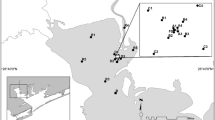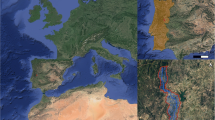Abstract
Wastewater disposal in coastal waters causes widespread environmental problems. Secondary treatment is expected to reduce the adverse effects of insufficiently treated wastewater. The environmental impact of sewage disposal via 18 wastewater treatment plants was analysed using the benthic opportunistic polychaetes and amphipods (BOPA) index. In previous studies this index proved to be an effective tool for monitoring sewage pollution. The impact of these discharges was highly related to treatment level, which ranged from pre-treatment to biological, as well as to flow rates and outfall position. Locations affected by pre-treated wastewater showed environmental degradation, especially marked near outfalls with higher flow rates. At most locations, biologically treated wastewater did not cause a significant impact and an improvement in ecological integrity was detected after this secondary treatment had been implemented. The impact of discharge was highly related to chemical oxygen demand (COD), suspended solids and nutrient concentrations, which are all lower in biologically treated wastewater. A ‘moderate’ ecological status was observed not only near sewage outfalls with high wastewater flow rates (>1,500,000 m3/month) with a COD over 200 mg/l but also near those with lower flow rates but with a COD over 400 mg/l. To reduce the impact of sewage disposal, it is necessary to carry out adequate treatment, have site outfalls deep enough, and implement water recycling.





Similar content being viewed by others
References
Borja, A., Muxika, I., & Franco, J. (2006). Long-term recovery of soft-bottom benthos following urban and industrial sewage treatment in the Nervión estuary (southern Bay of Biscay). Marine Ecology Progress Series, 313, 43–55.
Cardell, M. J., Sardá, R., & Romero, J. (1999). Spatial changes in sublittoral soft-bottom polychaete assemblages due to river inputs and sewage discharges. Acta Oecologica, 20, 343–351.
Chainho, P., Costa, J. L., Chaves, M. L., Dauer, D. M., & Costa, M. J. (2007). Influence of seasonal variability in benthic invertebrate community structure on the use of biotic indices to assess the ecological status of a Portuguese estuary. Marine Pollution Bulletin, 54, 1586–1597.
Cloern, J. E. (2001). Our evolving conceptual model of the coastal eutrophication problem. Marine Ecology Progress Series, 210, 223–253.
Dauvin, J. C., & Ruellet, T. (2007). Polychaete/amphipod ratio revisited. Marine Pollution Bulletin, 55, 215–224.
Dauvin, J. C., Ruellet, T., Desroy, N., & Janson, A. L. (2007). The ecology quality status of the Bay of Seine and the Seine estuary: use of biotic indices. Marine Pollution Bulletin, 55, 241–257.
De-la-Ossa-Carretero, J. A., & Dauvin, J. C. (2010). A comparison of two biotic indices, AMBI and BOPA/BO2A, for assessing the ecological quality status (EcoQS) of benthic macro-invertebrates. Transitional Water Bulletin, 4, 12–24.
De-la-Ossa-Carretero, J. A., Del-Pilar-Ruso, Y., Giménez-Casalduero, F., & Sánchez-Lizaso, J. L. (2009). Testing BOPA index in sewage affected soft-bottom communities in the north-western Mediterranean. Marine Pollution Bulletin, 58, 332–340.
De-la-Ossa-Carretero, J. A., Simboura, N., Del-Pilar-Ruso, Y., Pancucci-Papadopoulou, M. A., Giménez-Casalduero, F., & Sánchez-Lizaso, J. L. (2012). A methodology for applying taxonomic sufficiency and benthic biotic indices in two Mediterranean areas. Ecological Indicators, 23, 232–241.
Del-Pilar-Ruso, Y., de-la-Ossa-Carretero, J. A., Giménez-Casalduero, F., & Sánchez-Lizaso, J. L. (2010). Sewage treatment level and flow rates affect polychaete assemblages. Marine Pollution Bulletin, 60, 1930–1938.
Development Core Team, R. (2009). R: a language and environment for statistical computing. Vienna, Austria: R Foundation for Statistical Computing. http://www.r-project.org.
Diaz, R. J., & Rosenberg, R. (1995). Spreading dead zones and consequences for marine ecosystems. Science, 321, 926–929.
Díaz, R. J., Solan, M., & Valente, R. M. (2004). A review of approaches for classifying benthic habitats and evaluating habitat quality. Journal of Environmental Management, 73, 165–181.
Echavarri-Erasun, B., Juanes, J. A., Puente, A., & Revilla, J. A. (2010). Coastal outfalls, a sustainable alternative for improving water quality in north-east Atlantic estuaries. Journal of Environmental Monitoring, 12, 1737–1746.
Ganesh, T., Rakhesh, M., Raman, A. V., Nanduri, S., Moore, S., & Rajanna, B. (2014). Macrobenthos response to sewage pollution in a tropical inshore area. Environmental Monitoring and Assessment, 186, 3553–3566.
Gray, J. S., Aschan, M., Carr, M. R., Clarke, K. R., Green, R. H., Pearson, T. H., Rosemberg, R., & Warwick, R. M. (1988). Analysis of community attributes of the benthic macrofauna of Frierfjord/Langesundfjord and in a mesocosm experiment. Marine Ecology Progress Series, 46, 151–165.
Gray, J. S., Wu, R. S., & Or, Y. Y. (2002). Effects of hypoxia and organic enrichment on the coastal marine environment. Marine Ecology Progress Series, 238, 249–279.
Holme, N. A., & McIntyre, A. D. (1984). Methods for the study of marine benthos (2nd ed.). London: Blackwell.
Islam, M. S., & Tanaka, M. (2004). Impacts of pollution on coastal and marine ecosystems including coastal and marine fisheries and approach for management: a review and synthesis. Marine Pollution Bulletin, 48, 624–649.
Koop, K., & Hutchins, P. (1996). Disposal of sewage to the ocean: a sustainable solution? Marine Pollution Bulletin, 33, 121–123.
Liu, S., Lou, S., Kuang, C., Huang, W., Chen, W., Zhang, J., & Zhong, G. (2011). Water quality assessment by pollution-index method in the coastal waters of Hebei Province in western Bohai Sea, China. Marine Pollution Bulletin, 62, 2220–2229.
Moon, H. B., Yoon, S. P., Jung, R. H., & Choi, M. (2008). Wastewater treatment plants (WWTPs) as a source of sediment contamination by toxic organic pollutants and fecal sterols in a semi-enclosed bay in Korea. Chemosphere, 73, 880–889.
Muxika, I., Borja, A., & Bonne, W. (2005). The suitability of the marine biotic index (AMBI) to new impact sources along European coasts. Ecological Indicators, 5, 19–31.
Rakocinski, C. F., Brown, S. S., Gaston, G. R., Heard, R. W., Walker, W. W., & Summers, J. K. (1997). Macrobenthic responses to natural and contaminant-related gradients in northern Gulf of Mexico estuaries. Ecological Applications, 7, 1278–1298.
Sandrini-Neto, L. & Camargo, M. G. (2011). GAD: analysis of variance from general principles. R package version 1.1.1. Available at http://www.r-project.org.
Shuai, X., Bailey-Brock, J. H., & Lin, D. T. (2014). Spatio-temporal changes in trophic categories of infaunal polychaetes near the four wastewater ocean outfalls on Oahu, Hawaii. Water Research, 58, 38–49.
Simboura, N., Zenetos, A., & Pancucci-Papadopoulou, M. A. (2014). Benthic community indicators over a long period of monitoring (2000–2012) of the Saronikos Gulf, Greece, Eastern Mediterranean. Environment Monitoring and Assessment, 186, 3809–3821.
Stamou, A. I., & Kamizoulis, G. (2009). Estimation of the effect of the degree of sewage treatment on the status of pollution along the coastline of the Mediterranean Sea using broad scale modelling. Journal of Environmental Management, 90, 931–936.
UWWTD. (1991). Council Directive 91/271/EEC of 21 May 1991 concerning urban wastewater treatment.
Wilson, J. G., & Jeffrey, D. W. (1994). Benthic biological pollution indices in estuaries. In K. J. M. Kramer (Ed.), Biomonitoring of coastal water and estuaries (pp. 311–327). Baton Rouge, USA: CRC Press.
Xu, J., Lee, J. H. W., Yin, K., Liu, H., & Harrison, P. J. (2011). Environmental response to sewage treatment strategies: Hong Kong’s experience in long term water quality monitoring. Marine Pollution Bulletin, 62, 2275–2287.
Zarzo Martínez, D. (2008). Desarrollo, implantación y tecnología de las EDARs. Madrid, Spain: Actas curso. Internacional Faculty for Executives. IFAES.
Acknowledgments
We gratefully acknowledge CONSOMAR S.A. and Entitat de Sanejament d’Aigües for their financial contribution to this project. We also thank the staff of the Department of Marine Sciences and Applied Biology of University of Alicante, especially Y. Mugica, M. Diaz-Valdes and C. Celdrán for their invaluable collaboration. Thanks to Guido Jones for revising the English text.
Author information
Authors and Affiliations
Corresponding author
Ethics declarations
This article complies with editorial and publication policies as well as ethical standards of environmental monitoring and assessment. All procedures performed were in accordance with the ethical standards of the University of Alicante. Informed consent was obtained from all individual participants included in the study.
Conflict of interest
The authors declare that they have no conflicts of interest, and funding agencies are informed.
Rights and permissions
About this article
Cite this article
de-la-Ossa-Carretero, J.A., Del-Pilar-Ruso, Y., Giménez-Casalduero, F. et al. Monitoring the effects of wastewater treatment strategies. Environ Monit Assess 188, 110 (2016). https://doi.org/10.1007/s10661-016-5092-y
Received:
Accepted:
Published:
DOI: https://doi.org/10.1007/s10661-016-5092-y




